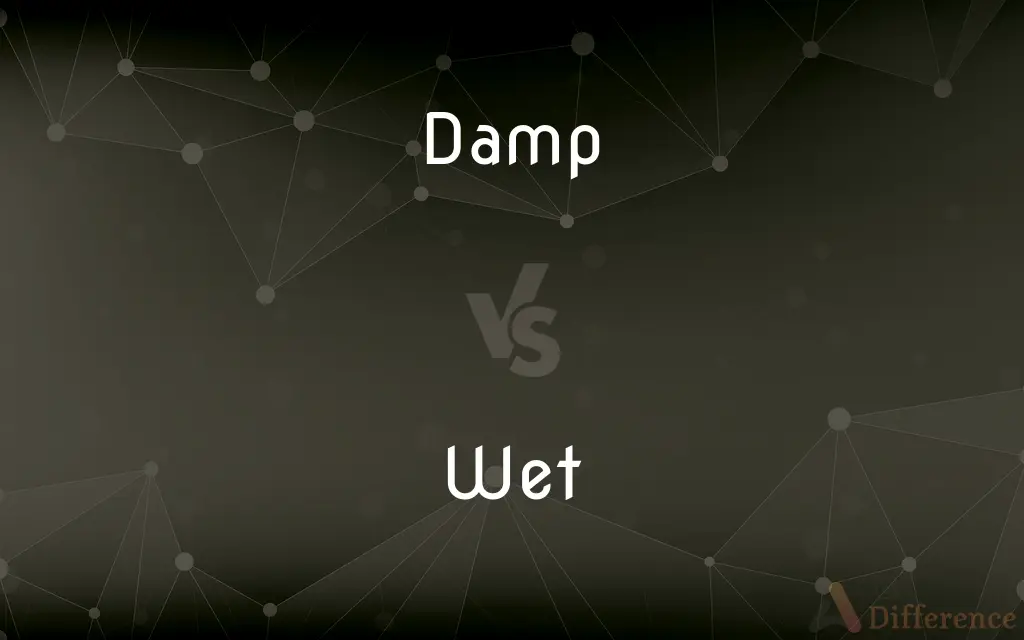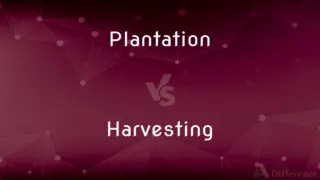Damp vs. Wet — What's the Difference?
Edited by Tayyaba Rehman — By Urooj Arif — Updated on March 4, 2024
Damp describes objects slightly moist, suggesting a lesser degree of wetness, while wet indicates more thoroughly soaked or covered in liquid.

Difference Between Damp and Wet
Table of Contents
ADVERTISEMENT
Key Differences
Damp is used to describe a slight amount of moisture, often implying that something is not fully dry but not soaking either. For example, after a light mist, a towel might feel damp to the touch, suggesting it has absorbed some moisture but is not dripping wet. On the other hand, wet is used when something has absorbed or is covered in liquid to a greater extent. A towel drenched after being submerged in water would be considered wet, as it is thoroughly soaked and likely to drip if picked up.
While dampness often refers to the presence of moisture in a way that slightly alters the texture or temperature of an object, it doesn't usually result in water being squeezed out or dripping. A damp sponge, for instance, might feel cool and slightly moist but won’t necessarily leave water trails. Wet, however, implies a more pronounced presence of liquid. A wet sponge is so saturated that squeezing it would release a significant amount of water, making it clear that the sponge is more than just slightly moist.
Damp environments or conditions are typically associated with humidity or the aftermath of very light precipitation, suggesting an atmosphere or surface that is slightly moist but not visibly wet. This can affect the sensation of the air or the feel of surfaces without leaving visible water. Wet conditions, conversely, are unmistakably characterized by the presence of liquid, whether from heavy rainfall, spills, or submersion, leading to surfaces that are visibly soaked or areas that are covered in water.
In terms of impact, dampness can affect materials by making them slightly colder or causing a subtle change in texture, but it rarely leads to the structural changes or damage associated with being wet. Mildew growth in fabrics, for instance, can occur in damp conditions due to the prolonged presence of moisture. Wetness, by its nature, can significantly alter or damage materials, causing warping, staining, or even the breakdown of certain substances. For example, prolonged exposure to wet conditions can ruin wood furniture or cause metal to rust.
The perception of damp vs. wet also varies depending on the context and the observer's expectations. In some cases, what one person describes as damp, another might consider wet, based on their interpretation of the amount of moisture present. This subjective aspect highlights the continuum of moisture levels from dry to soaking, with damp and wet serving as descriptors on this scale.
ADVERTISEMENT
Comparison Chart
Degree of Moisture
Slight, just enough to be noticeable
High, enough to saturate or cover completely
Sensation
Cool, slightly moist without dripping
Soaked, capable of dripping or flowing liquid
Typical Causes
Humidity, light mist, condensation
Rain, spills, submersion
Impact on Materials
Minor changes in texture or temperature
Possible damage, alteration, or saturation
Perception
Subjective, often seen as less than wet
Clearly noticeable, universally recognized as more saturated
Compare with Definitions
Damp
Slightly moist
The basement walls are damp from the recent rains.
Wet
Soaked with water
The rain left the streets wet and puddled.
Damp
Lightly wetted
He wiped his face with a damp cloth.
Wet
Covered in or saturated with liquid
She left her wet clothes on the bathroom floor.
Damp
Not fully dry
After a light drizzle, the garden soil was damp.
Wet
Having a surface covered in water
The wet deck was slippery after the storm.
Damp
Mildly humid
The air feels damp on foggy mornings.
Wet
Not dry or damp, but thoroughly moistened
His shoes were wet after walking through the puddles.
Damp
Minimally soaked
The towels felt damp after being in the steamy bathroom.
Wet
Dripping with water
The dog's fur was wet after its bath.
Damp
Slightly wet
A damp sponge.
Wet
Covered or saturated with water or another liquid
She followed, slipping on the wet rock
Damp
Humid
Damp air.
Wet
Cover or touch with liquid; moisten
He wetted a finger and flicked through the pages
Damp
In a state between dry and wet; moderately wet; moist.
The lawn was still damp so we decided not to sit down.
The paint is still damp, so please don't touch it.
Wet
Liquid that makes something damp
I could feel the wet of his tears
Damp
Moisture; humidity; dampness.
Wet
Covered or soaked with a liquid, such as water
A wet towel.
Damp
To dampen; to make moderately wet
To damp cloth
Wet
Made up of liquid or moisture, usually (but not always) water.
Water is wet.
Damp
Moisture; humidity; fog; fogginess; vapor.
Night . . . with black airAccompanied, with damps and dreadful gloom.
Wet
Containing, or consisting of, water or other liquid; moist; soaked with a liquid; having water or other liquid upon the surface; as, wet land; a wet cloth; a wet table.
Damp
A slight wetness
Wet
To fill or moisten with water or other liquid; to sprinkle; to cause to have water or other fluid adherent to the surface; to dip or soak in a liquid; as, to wet a sponge; to wet the hands; to wet cloth.
Ye mists and exhalations, that now rise . . . Whether to deck with clouds the uncolored sky,Or wet the thirsty earth with falling showers.
Let us drink the other cup to wet our whistles.
Damp
Slightly wet;
Clothes damp with perspiration
A moist breeze
Eyes moist with tears
Wet
Covered or soaked with a liquid such as water;
A wet bathing suit
Wet sidewalks
Wet paint
Wet weather
Common Curiosities
Is dampness always a sign of inadequate drying?
Not always; it can also indicate exposure to humid conditions or slight moisture.
How can you tell if something is wet?
If it's saturated with liquid, causing it to drip or be thoroughly soaked, it's wet.
Why do some materials feel damp in humid weather?
They absorb moisture from the air, leading to a slightly moist sensation.
Does dampness disappear on its own?
It can, especially in well-ventilated or dry conditions.
Can humidity alone make something wet?
No, humidity typically causes dampness, not wetness.
What does it mean when something is damp?
When something is damp, it means it has a slight amount of moisture, making it feel slightly wet but not soaked.
Can clothes be both damp and wet?
Clothes are considered damp when slightly moist and wet when thoroughly soaked.
Are there health concerns with damp environments?
Yes, damp conditions can promote mold and mildew growth, which may affect health.
How does wetness affect wood and metal?
Wetness can cause wood to warp and metal to rust, damaging them over time.
Is it possible for air to feel wet?
Yes, when humidity levels are high, air can feel wet due to moisture content.
What causes something to become wet?
Exposure to liquid, such as water, rain, or spills, makes something wet.
Why do towels feel damp after use in a steamy bathroom?
They absorb moisture from the air and steam, becoming slightly moist.
What's the best way to dry a wet object?
Exposure to air, sunlight, or heat can effectively dry a wet object.
Can weather be described as damp?
Yes, especially when there is light mist or fog contributing to a slightly moist atmosphere.
What is the difference between damp and moist?
Damp often implies a slightly negative condition of being slightly wet, whereas moist can be neutral or positive, depending on the context.
Share Your Discovery

Previous Comparison
Bosslike vs. Boss
Next Comparison
Plantation vs. HarvestingAuthor Spotlight
Written by
Urooj ArifUrooj is a skilled content writer at Ask Difference, known for her exceptional ability to simplify complex topics into engaging and informative content. With a passion for research and a flair for clear, concise writing, she consistently delivers articles that resonate with our diverse audience.
Edited by
Tayyaba RehmanTayyaba Rehman is a distinguished writer, currently serving as a primary contributor to askdifference.com. As a researcher in semantics and etymology, Tayyaba's passion for the complexity of languages and their distinctions has found a perfect home on the platform. Tayyaba delves into the intricacies of language, distinguishing between commonly confused words and phrases, thereby providing clarity for readers worldwide.














































